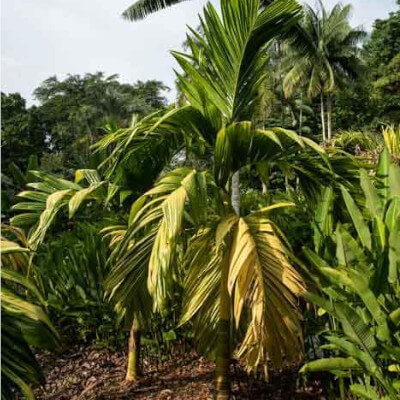
Areca catechu, often called the Betel Nut Palm, is a tropical palm that stands out for its elegance and utility. Originating from Southeast Asia, it is primarily cultivated for its betel nuts but also beautifies gardens and green spaces. Indeed, this palm, which can reach an impressive height of 20 to 30 metres, has a slender, straight, and smooth trunk, often marked by natural rings. Additionally, its long, pinnate leaves, of a vibrant green, offer a recognizable silhouette that immediately evokes exotic landscapes.
Furthermore, this palm thrives in humid tropical climates, primarily on well-drained soils rich in organic matter. At the Au Bois Vert Botanical Garden, located in Ivato, near Antananarivo, the Areca catechu or Betel Nut Palm holds a place of honour. Its majestic form and its capacity to provide shade make it a highly prized plant for landscaping. Thus, it is often found near hotels, restaurants, and lodges in the region, where it contributes to a calming and natural ambiance.
The Areca catechu also presents a subtle flowering throughout the year, with suspended inflorescences that develop in clusters. Indeed, these flowers give rise to ovoid fruits, known as betel nuts, encased in a fibrous husk. These fruits are not only aesthetically pleasing; they hold significant cultural and economic value in many tropical regions. Their popularity is such that this palm remains indispensable in botanical gardens and carefully maintained tropical environments.
Finally, the Au Bois Vert Botanical Garden particularly highlights this emblematic plant, allowing visitors to discover its many facets. Through its uses, ecological role, and aesthetics, the Betel Nut Palm contributes to making this space a true tropical oasis near Antananarivo.
Plant use
Areca catechu is a versatile plant that plays a key role in several cultures and industries. The betel nuts, the main asset of the Betel Nut Palm, are highly appreciated in South and Southeast Asia. Traditionally consumed in the form of betel, they are chewed for their stimulating effects. This mixture, composed of betel nuts, betel leaves, and lime, has been used for centuries for its energising properties. This practice is particularly widespread in India, Indonesia, and Sri Lanka. In traditional medicine, betel nuts also serve as natural remedies. They are reputed for their vermifuge properties and their efficacy in treating certain digestive disorders. However, their excessive consumption can present risks, which limits their use in modern medicine. Beyond their fruits, other parts of the Betel Nut Palm find practical applications. Its robust and straight trunk is used in the construction of light and temporary structures in rural areas. The leaves, flexible and resistant, are often woven to create baskets, mats, or even biodegradable plates. These artisanal products are part of an ecological and sustainable approach. At the Au Bois Vert Botanical Garden, the Betel Nut Palm is a source of inspiration for visitors, who discover its cultural and ecological importance. Its ornamental role is just as essential. In the hotels, restaurants, and lodges of Ivato, it contributes to creating a tropical atmosphere that appeals to tourists seeking a change of scenery. This plant, both useful and decorative, perfectly embodies the spirit of sustainability and harmony with nature promoted by places like Au Bois Vert.
Key information
| Common name | Betel Nut Palm |
| Scientific name | Areca catechu |
| Origin | Southeast Asia |
| Natural habitat | Tropical rainforests |
| Life cycle | Perennial |
| Flowering period | All year round under optimum conditions |


